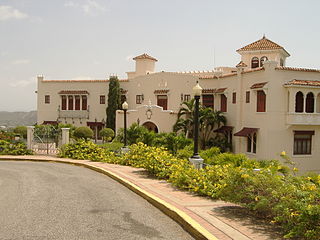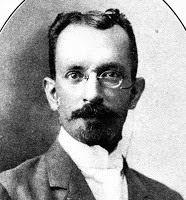
Juan Eugenio Serrallés Colón (1836–1921) was the founder of Hacienda Mercedita in Ponce, Puerto Rico, and what was to become Destileria Serralles, producers of "Don Q", a brand of Puerto Rican rum.

Castillo Serrallés is a mansion located in the city of Ponce, Puerto Rico, overlooking the downtown area. It was built during the 1930s for Juan Eugenio Serrallés, son of businessman Juan Serrallés, founder of Destilería Serrallés. The structure sits on a 2.5-acre (1.0 ha) exceedingly manicured property. Nowadays, the structure functions as a museum, Museo Castillo Serrallés, with information about the sugar cane and rum industries and its impact in the economy of Puerto Rico. It is also increasingly used as a venue for social activities, including destination weddings. The property was listed in the National Register of Historic Places in 1980. In 1996, the structure was featured in the American TV series America's Castles.

The Panteón Nacional Román Baldorioty de Castro is a tract of land in Barrio Segundo of the city of Ponce, Puerto Rico, originally designed as the city's cemetery, but later converted into what has come to be a famous burial place. Established in 1842, it is Puerto Rico's first national pantheon. It is the only cemetery dedicated as a museum in Puerto Rico and the Caribbean. Prior to being dedicated as a Panteón Nacional, it was known as Cementerio Viejo or as Cementerio Antiguo de Ponce, and is listed under that name on the U.S. National Register of Historic Places. The Pantheon is named after Román Baldorioty de Castro, a prolific Puerto Rican politician, and firm believer of Puerto Rican autonomy and independence. His remains are located here. The Pantheon also houses a small museum about the history of autonomism in the Island, and it is currently used both as a park and a venue for the expression of culture and the arts. It is called the Museo del Autonomismo Puertorriqueño.

The Museo de la Música Puertorriqueña is a museum in Ponce, Puerto Rico, that showcases the development of Puerto Rican music, with displays of Taíno, Spanish, and African musical instruments that were played in the romantic danza genre, the favorite music of 19th-century Puerto Rican high society, as well as the more African-inspired bomba and plena styles. Also on display are memorabilia of composers and performers. The Museum traces the rich musical history of Puerto Rico through memorabilia of prominent musicians and displays of the musical instruments associated with the three genres of music that originated in this Caribbean island.

José de Guzmán Benítez was Mayor of Ponce, Puerto Rico, from 28 February 1901 until 1902. José de Guzmán Benítez is best known for his 1899 campaign initiative, presented to the people of Puerto Rico, asking for the creation of a pro-American political party.

Blas C. Silva Boucher was a twentieth-century Puerto Rican engineer from Ponce, Puerto Rico. He is credited with the creation of the Ponce Creole architectural style, even though he was trained as an engineer, not a designer.

Ponce Creole is an architectural style created in Ponce, Puerto Rico, in the late 19th and early 20th century. This style of Puerto Rican buildings is found predominantly in residential homes in Ponce that developed between 1895 and 1920. Ponce Creole architecture borrows heavily from the traditions of the French, the Spaniards, and the Caribbean to create houses that were especially built to withstand the hot and dry climate of the region, and to take advantage of the sun and sea breezes characteristic of the southern Puerto Rico's Caribbean Sea coast. It is a blend of wood and masonry, incorporating architectural elements of other styles, from Spanish Revival to Victorian.

Casa Salazar-Candal is a historic building located on the southeast corner of Isabel and Mayor Cantera streets in Ponce, Puerto Rico, in the city's historic district. The building dates from 1911. It was designed by the architect Blas Silva. The architecture consists of 19th Classical revival, Art Nouveau and Spanish Revival architectural styles. Today the Salazar–Candal Residence houses the Museum of the History of Ponce.

Juan Bertoli Calderoni was a nineteenth-century French architect from Bastia, Corsica, and long-time resident of Ponce, Puerto Rico, where he designed various prominent structures including Teatro La Perla, Casa Serrallés, and Residencia Ermelindo Salazar among various other historic building.

Casa Serrallés is a historic building in the city of Ponce, Puerto Rico. It was built in 1911 by Alfredo Wiechers Pieretti for Don Juan Eugenio Serrallés Pérez, son of businessman Juan Serrallés Colón, founder of Destilería Serrallés, and himself the CEO of the company that founded Ron Don Q. The building is currently home to the Museo de la Música Puertorriqueña.

Centro Cultural Carmen Solá de Pereira de Ponce is the cultural center of the city of Ponce, and is located at 70 Cristina street in the Ponce Historic Zone, in Barrio Tercero, Ponce, Puerto Rico. The Center is located in a structure designed in 1870, and it is currently used for educational and cultural activities as well as for art exhibits. Centro Cultural de Ponce was founded on 12 November 1963.

Ermelindo Salazar Schuck was interim Mayor of Ponce, Puerto Rico, from May to 10 July 1887. He filled the mayoral post between the resignation of mayor Ramón Elices Montes and the arrival of Fernando Diez de Ulzurrún y Somellera, who was appointed mayor by the Central Provincial Government.

America's Castles is a documentary television series that aired on A&E Network from 1994 to 2005. Through interviews, historic photos and newly shot footage, the program documents the mansions and summer homes of the high society of The Gilded Age. The series is narrated by Joe van Riper and many episodes feature architectural expert Richard Guy Wilson.

Casa Rosita Serrallés is a historic building in the city of Ponce, Puerto Rico, located between the former Escuela Libre de Música Juan Morel Campos and the Museo de la Historia de Ponce, and immediately behind Teatro La Perla, on Calle Salud street. It was built for one of the heirs of Juan Eugenio Serrallés Perez, son of businessman Juan Serrallés Colón, founder of Destilería Serrallés, and himself the CEO of the company that founded Ron Don Q. The building was purchased by the government of the Autonomous Municipality of Ponce in 2008 for its architectural, historic, and cultural value. As of February 2012, the building was being restored to convert it into an annex of the Museo de la Historia de Ponce to depict the 1985 Mameyes tragedy of barrio Portugues Urbano in Ponce. In 2014 it opened as "Museo de la Recordacion Barrio Mameyes" under Ponce mayor María Meléndez at Calle Salud 67. It is also known as "Sala Memorial del Barrio Mameyes" as it operates as a part of the Museo de la Historia de Ponce.

Museo Castillo Serrallés, a.k.a. Museo de la Caña y el Ron, is an agricultural museum in the city of Ponce, Puerto Rico, that showcases the history of sugar cane, its derivative rum industry, and their impact in the economy of Puerto Rico. The most notorious feature of the museum is the building it occupies. The building is a large four-story structure built in the 1930s for the owner of Ponce's Destileria Serralles, one of Puerto Rico's largest rum distilleries. The distillery was once also home to Puerto Rico's largest sugar-factory called Central Mercedita, producers of the Snow White sugar brand. The building, known as Castillo Serrallés, was designed by Pedro Adolfo de Castro in 1930 in the Spanish Colonial Revival style.

Residencia Ermelindo Salazar is a historic house in Ponce, Puerto Rico. It was built in 1870 as the home of Ermelindo Salazar, a prominent citizen and businessman in the city as well as its mayor in 1880. It is located at 70 Cristina street in the Ponce Historic Zone, in Barrio Tercero, Ponce, Puerto Rico. Today the house serves as the headquarters of the Centro Cultural de Ponce Carmen Solá de Pereira, the cultural center of the city of Ponce, where it is used for educational and cultural activities as well as for art exhibits.

The Acueducto de Ponce, formally Acueducto Alfonso XII, is the name of a historic 2.5-mile gravity-based water supply system in the city of Ponce, Puerto Rico. It was designed in 1875 by Timoteo Luberza and built the following years. This aqueduct was the first modern water distribution system built in Puerto Rico. The Aqueduct was known as El Puente de los Suicidios. It was declared a National Historic Monument on 17 June 2015.

Museo Parque de Bombas is a museum located inside the historic Parque de Bombas in the Ponce Historic Zone in Ponce, Puerto Rico.
















